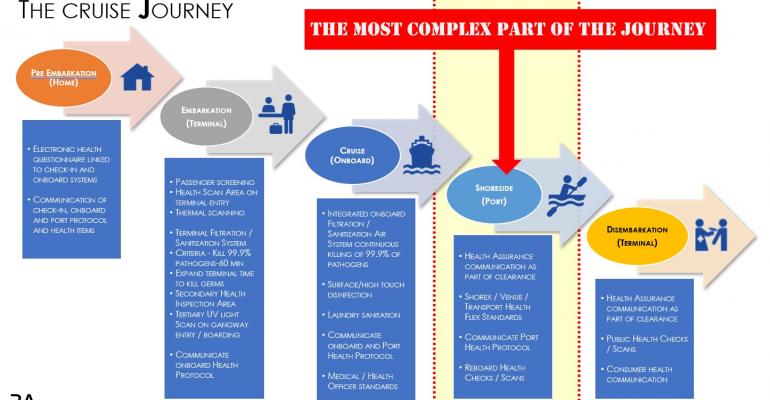If they don't take a leadership stance, they may be left out — either bypassed because they can't provide the kind of health safety assurances needed, or missing out on economic impact as lines craft their own 'bubbles.'
A safe return to operations doesn't just entail the ships; it's a journey — and the port call is the most complex part of the journey, according to Luis Ajamil, president and CEO, Bermello Ajamil & Partners (B&A).
'Not much time left'
Ajamil is alerting ports: 'There is not much time left,' adding 'There's so much work to be done.'
Recently B&A has laid out the considerations in presentations to Skagway and Ketchikan in Alaska, the American Association of Port Authorities and Cruise Europe members. Upcoming presentations are planned for Destinations Together on Dec. 2 and Cruise the Saint Lawrence on Dec. 30.
Under the US Centers for Disease Control and Prevention's framework for resuming cruises, lines need to have a plan agreed with US port and local health authorities that addresses several points. These include evacuation to onshore hospitals for passengers and crew in need of care and a housing agreement with one or more shoreside facilities for isolation and quarantine of COVID-19 cases and their close contacts.
Ports need to decide their carrying capacity now
Also required is an agreement between the ship operator and port authority to determine the number of cruise ships at any single port so as to not overburden the public health response resources of any single jurisdiction in the event of a COVID-19 outbreak.
Ports are 'going to have to make that determination,' Ajamil said, bearing in mind that, initially, ships will be operating at lower capacity. It's something that needs to be done now, since lines have to know where they can send ships.
Scalability
In his latest presentation, to Ketchikan, Ajamil stressed any plan ports come up with must be scalable.
For example, COVID-19 testing requirements are going to be extremely rigorous in the beginning, but it's likely those could be relaxed toward the end of the Alaska season since, potentially, 150m Americans will have been vaccinated.
Distancing will have a major impact
The need to provide for distancing of passengers will have a big impact, not just on turnaround ports but at transit ports. It could take two to three times longer to get everyone ashore and that will impact all tours and the time in port, even with ships at reduced capacity.
Terminal areas for health screening and isolation must be though out, and ventilation is a critical factor.
Seven 'bubble' variations
In addressing Ketchikan leaders, Ajamil described seven variations on 'bubbles.' One could mean no visitation — that ships sailing from the US call at Canadian ports, provided Canada allows cruises, and bypass Ketchikan.
Another bubble scenario could involve allowing a few businesses to operate inside the port. Or a wider area could be opened to include more commercial operators by means of temporary fencing, like a fairground. But everyone in that bubble would have to be regularly tested.
There could be a passenger bubble scenario, where travelers get on motor coaches for controlled tours, as in Europe, and as envisioned by the Healthy Sail Panel recommendations, but are not free to roam on their own.
Or, a port might create an area-wide bubble, where traffic can enter but visitors and locals can't interact. A city-wide bubble may be possible for an island port like Ketchikan, however everyone living there would have to be controlled and tested.
An integrated model might consider all of Alaska a bubble, as the state initially was, with a PCR test required for anyone to enter, though Ajamil considers this option highly unlikely.
Independent tours allowed or not?
Will ports allow only the cruise line shore excursions, or is there a way to handle independent tours? If so, how will these be regulated and certified? By the port? The city? A health agency? The same goes for commercial venues such as shops and food and beverage providers.
Ajamil noted Ketchikan is ahead of many communities since it's already assembled a cruise task force. But tough decisions lie ahead. All stakeholders need to convene, and there will be conflicting interests.
How will the bubble be defined? How will the operations within that bubble work? How will port capacity be set?
Developing a plan will be the hardest part, the B&A chief said. Then come implementation and monitoring/reporting since the CDC will be keeping tabs on operations.
Who pays?
Who pays for all these things?
Ajamil thinks customers are willing to pay for a healthy vacation. Whether costs will be bundled into the cruise fare or passed along as an additional cost or tariff or perhaps added on to tour prices remains to be seen.
'This is a huge undertaking,' Ajamil reiterated. But, he added, 'A safe destination will be a magnet.'
Copyright © 2024. All rights reserved. Seatrade, a trading name of Informa Markets (UK) Limited.
Add Seatrade Cruise News to your Google News feed.  |

